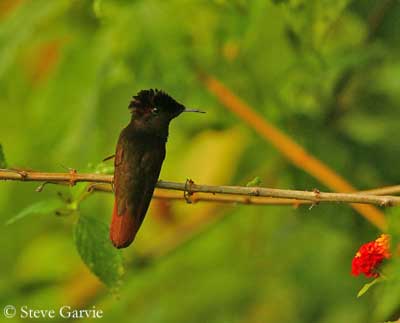
Fr: Colibri rubis-topaze
All : Moskitokolibri
Esp: Colibrí Rubí
Ital: Colibrì rubino-topazio
Nd: Rode Kolibrie
Sd : Topaskolibri
Port: Beija-flor-vermelho
Photographers :
Chrétien Marc
MURINUS
Garvie Steve
RAINBIRDER Photo galleries
Patrick Ingremeau
TAMANDUA
Wolfer Philippe
OISEAUX D’ARGENTINE
Texte de Nicole Bouglouan
Sources :
HANDBOOK OF THE BIRDS OF THE WORLD Vol 5 by Josep del Hoyo-Andrew Elliott-Jordi Sargatal - Lynx Edicions - ISBN: 8487334253
A GUIDE TO THE BIRDS OF COLOMBIA by Steven L. Hilty and William L. Brown - Princeton University Press – ISBN 069108372X
Arthur Grosset's Birds (Arthur Grosset)
Discovering the birds of Trinidad and Tobago (Brian Ramsey)
Wikipedia (Wikipedia, The Free Encyclopedia)
Ruby-topaz Hummingbird
Chrysolampis mosquitus
Apodiforme Order – Trochilidae Family
BIOMETRICS:
Length: 8-9 cm
Weight: 4-5 g
DESCRIPTION:
As numerous hummingbirds, the Ruby-topaz shows various appearances and colours according to the lighting.
When perched in shade, this bird appears dull blackish-brown, but when the sun touches lightly its feathers, it becomes a jewel!

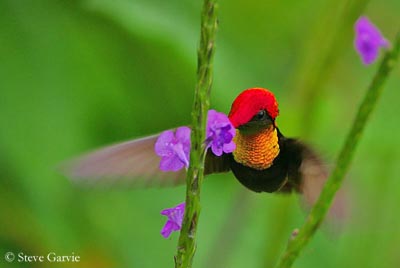
The adult male has dark brown body with dull olive gloss. The wings are dark grey. The tail is bright chestnut with black tip.
On the underparts, throat and breast are iridescent golden, or occasionally emerald-green.
The head shows shiny ruby-red forehead, crown and nape, sometimes more orange.
The black bill is short and straight. The eyes are dark brown. Legs and feet are blackish.
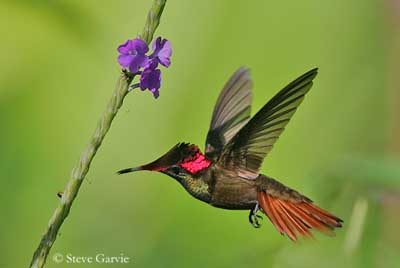
The female has copper-green upperparts. The tail shows olive-green central rectrices whereas the others are bright chestnut. We can see a dark purple subterminal band and white tips.
The underparts are pale grey. The birds from Trinidad and Tobago have sometimes a greenish-golden stripe from the chin, down to the breast.
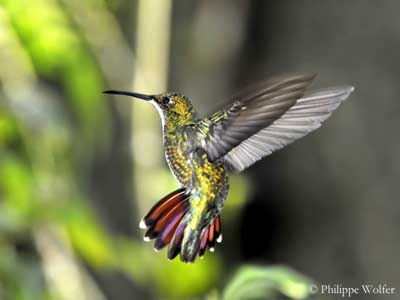
The immature resembles adult female. It has a white spot behind the eye. On the tail, the outer rectrices are dark violet with white tips.
VOICE: SOUNDS BY XENO-CANTO
The Ruby-topaz Hummingbird utters high-pitched chirps and whistles. The calls are very short and given from an exposed perch as advertising sounds “tliii, tliii, tliii…”
Aggressive calls are series of rapid chattering, uttered by both sexes.
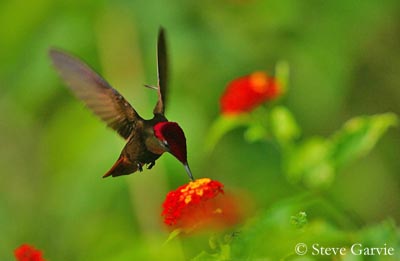
HABITAT:
The Ruby-topaz Hummingbird can be found in clearings, open country, cultivated areas and gardens where it forages from low down to treetops.
It is usually seen from sea-level to shrubby arid hillsides, up to 1700 metres of elevation, but often below 500 metres.
RANGE:
The Ruby-topaz Hummingbird breeds in tropical northern South America, from S Panama, Colombia, Venezuela and the Guyanas, southwards to C Brazil and N Bolivia.
It also occurs on islands, in the Lesser Antilles, Trinidad and Tobago.
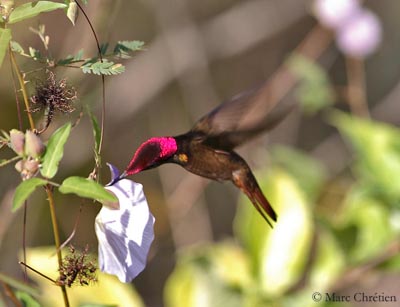
BEHAVIOUR:
The Ruby-topaz Hummingbird feeds on nectar from flowers of several plant species. It forages by hovering in front of the flower, and reaches the nectar with the bill, and mainly the tongue.
It also catches insects by hawking while feeding on nectar or in the air. It may sometimes forage among the foliage, searching for arthropods.
The feeding territories including flowering trees, shrubs or cacti, are defended by the male which gives series of aggressive and rapid chattering.
The Ruby-topaz Hummingbird is often seen alone at the feeding sources, and at variable heights.
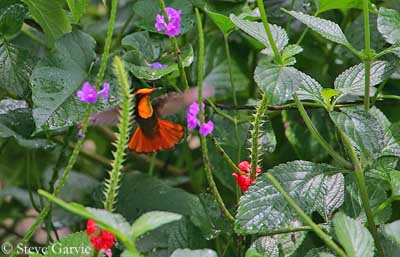
During the breeding season, the male performs some displays. It revolves quickly around the female and displays its rich colours by fanning widely the chestnut tail and raising the ruby-red crown feathers.
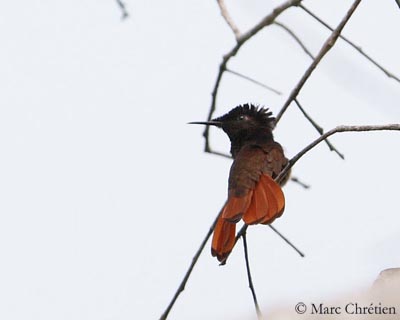
The Ruby-topaz Hummingbird is migratory. It performs N-S migrations within Brazil. It travels along the coastal regions of the Guyanas, Venezuela and Colombia, probably doing an E-W migration, and moves southwards to Colombia where it arrives in May, and leaves in September.
Some migratory movements are suspected on Trinidad and Tobago.
FLIGHT:
As all the hummingbirds, the Ruby-topaz hovers forwards and backwards when feeding on nectar.
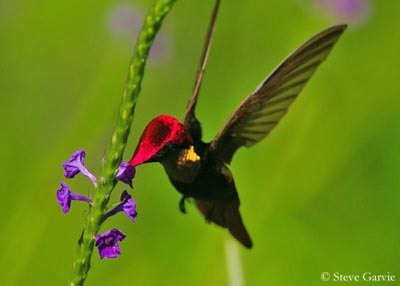
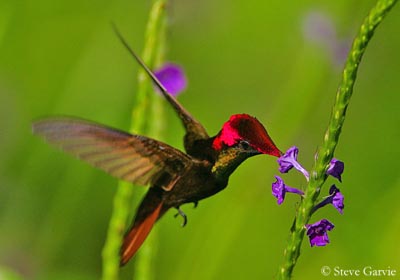
REPRODUCTION:
The breeding season varies according to the range, from December-June on Trinidad and Tobago, Venezuela and Guyanas, to September-January in Brazil.
The tiny nest is saddled in fork of small branch, at about one to four metres above the ground. The cup-shaped nest is made with fine materials such as plant fibres and spider webs. The outside is decorated with lichens and pieces of bark.
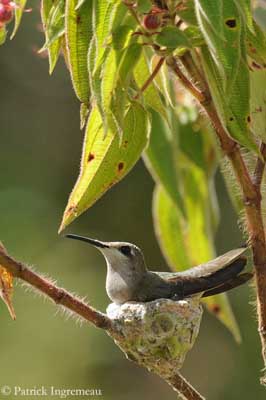
The female lays two eggs, and incubates during 15-16 days. At hatching, the black chicks are covered in sparse brownish down on the back. They fledge about three weeks after hatching.
They can breed in the second year.
DIET:
The Ruby-topaz Hummingbird feeds on nectar from flowers of trees, shrubs, cacti and cultivated plant species.
It also catches insects by hawking in the air, and forages in foliage for arthropods.
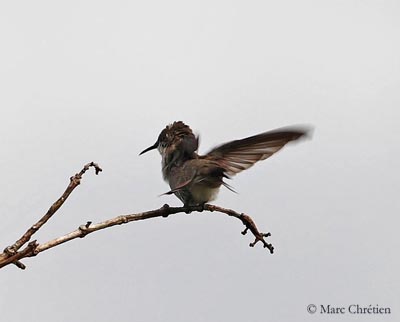
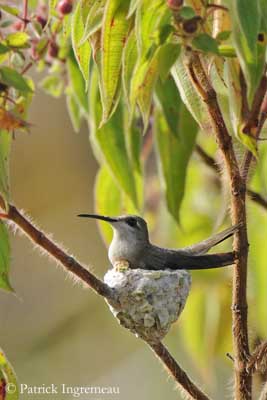
PROTECTION / THREATS / STATUS:
The Ruby-topaz Hummingbird is common in lowlands and coastal regions. It accepts man-made habitats and frequents gardens and cultivated areas.
After serious decline due to illegal bird trade in Brazil in the 1970s, the species has now stable populations, and the Ruby-topaz Hummingbird is not threatened at this moment.